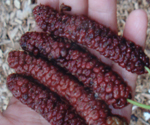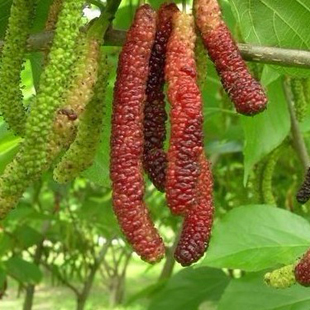
Growth Habit: All three mulberry species are deciduous trees of varying sizes. The black mulberry is the smallest of the three, sometimes growing to 30 ft. in height, but it tends to be a bush if not trained when it is young. The species vary greatly in longevity. Red mulberry trees rarely live more than 75 years, while black mulberries have been known to bear fruit for hundreds of years. The mulberry makes an attractive tree which will bear fruit while still small and young.
Fruit: Black mulberry fruits are large and juicy, with a good balance of sweetness and tartness that makes them the best flavored species of mulberry. The refreshing tart taste is in some ways reminiscent of grapefruit. Mulberries ripen over an extended period of time unlike many other fruits which seem to come all at once. Propagation: Mulberries can be grown from seed, although the plants can take 10 years or more to bear. Seed should be sown as soon as extracted from the fruit. Sprig budding is the most common method for grafting mulberries. A T-cut is made in the rootstock and a smooth, sloping cut is made on the lower end of the scion. Black mulberries are also somewhat difficult to propagate since they tend to bleed a lot. |

